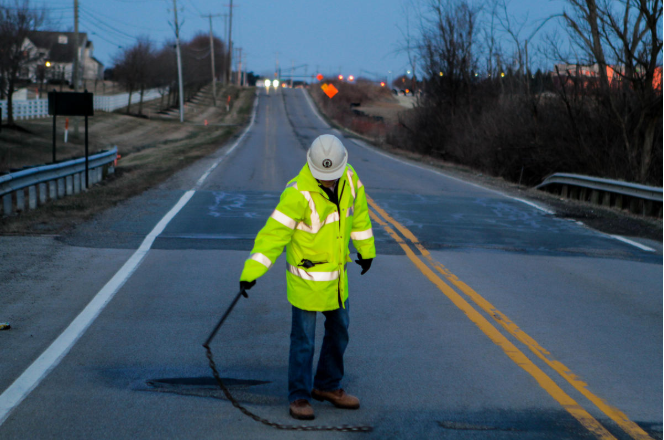Ed Herrick offers me a bright yellow reflective vest with reflective tape and starts rummaging around in his car. He pulls out a metal baton with a long chain attached to one end and starts trudging toward a small bridge.
Franklin County’s bridge design engineer jokes it’s their “high tech” device for detecting potholes.
“You can see we’ve patched it a lot here,” Herrick says. “Because it’s been patched a lot, there’s leakage that’s taken place.”
He waits for a car to pass and walks out into the lane.
“Out here it looks like normal concrete, so you would not even think there was a problem,” Herrick says as he starts dragging the chain back and forth. “I know there are a couple of bad areas out here.”
The fight over how much to increase Ohio’s gas tax has tied the General Assembly in knots for weeks. Talks broke down Friday, and lawmakers missed the midnight deadline to pass a transportation budget. They are not set to resume bargaining again until Tuesday. Where they’ll wind up is unclear, but it seems certain to be less than Gov. Mike DeWine’s original request of 18 cents per gallon.
While legislators debate, local governments are holding their breath, because a portion of gas tax revenue funds local infrastructure projects-like this bridge in northeast Franklin County.
As Herrick drags the chain over the bridge deck, the sound changes noticeably over one area-a hollow, deeper sound.
“Does not look like there’s a bad spot there, but there’s crack and what has happened is, as the moisture goes down in, freeze, thaw, and it begins to delaminate the concrete,” he says.
This Dublin-Granville Road bridge is small, just one lane each way over Rock Fork Creek, but the thoroughfare helps get people in New Albany to Route 161. It was built in 1951 and it shows.
Herrick explains it’s currently rated “poor.” That’s a four on a nine-point scale, where zero is your bridge washing down the river.
Underneath the bridge, Herrick points to one end where the abutment-the place where the bridge meets the land-remains intact. But along much of the rest, concrete has fallen away, leaving brown vertical streaks of rusted rebar.
“This, visually you can tell, but much in the same way that you’d do the concrete deck up above, dragging with a chain, we do this type of stuff underneath,” he says, swinging a hammer at the underside of the bridge. The sharp narrows peals give way to a flat clatter.
“Bad concrete-hear the difference?” He asks.
Franklin County Engineer Cornell Robertson says they’re planning on overhauling the bridge soon.
“Right now we’re looking to replace this is 2020,” Robertson says. “We estimate it will cost $ 1.2 million and currently about $ 250,000 shy.”
Robertson endorsed DeWine’s 18-cent increase, the largest proposal on the table, which came following a recommendation from a transportation panel assembled by the governor. He explains that, while rates for gas tax revenue remained static for more than a decade, construction costs have only grown.
“I think they approached it in a manner that they felt was appropriate but not overboard,” Robertson says.” So in other words, to go even lower than that we’re even more in a bind.”
Robertson also liked the governor’s idea of tying the gas tax to inflation. That proposal, however, was immediately thrown out by the Ohio General Assembly. Robertson notes there’s far more than just this bridge in need of repair-his office oversees almost 360 bridges across the county.
“Forty-eight is over 100 years old, 108 are over 75 years old, 13 are rated poor and 35 are rated fair,” Robertson rattles off from memory. “So those two groups of bridges are the ones that are next in line for either rehabilitation or replacement. We watch those very, very closely and we’re trying to get those designed and funding accounted for, for their repair. ”
Until the legislature approves a final transportation budget, Robertson will be waiting for a while longer.
